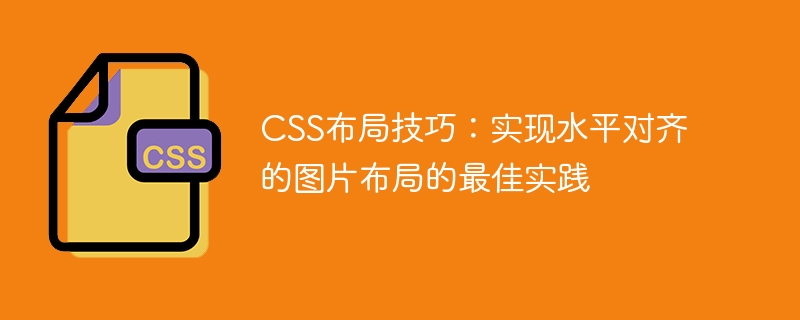
CSS布局技巧:实现水平对齐的图片布局的最佳实践
引言:
在网页设计中,图片的布局是非常重要的一部分。通过合理的布局方式,可以使网页更加美观和吸引人。本文将介绍如何使用CSS来实现水平对齐的图片布局的最佳实践,并提供具体的代码示例。
一、使用Flexbox布局
Flexbox是CSS3中的一个强大的布局模型,它可以实现高度灵活的布局。以下是使用Flexbox实现水平对齐的图片布局的代码示例:
<div class="image-container">
@@##@@
@@##@@
@@##@@
</div>
<style>
.image-container {
display: flex;
justify-content: center;
align-items: center;
}
</style>在上述代码中,将三张图片放置在一个名为"image-container"的容器内。通过设置容器的display属性为flex,然后使用justify-content属性设置水平对齐方式为center,align-items属性设置垂直对齐方式为center,就可以实现水平对齐的图片布局。
立即学习“前端免费学习笔记(深入)”;
二、使用Grid布局
Grid布局是CSS3中另一个强大的布局模型,它可以实现多列和多行的布局。以下是使用Grid布局实现水平对齐的图片布局的代码示例:
<div class="image-container">
@@##@@
@@##@@
@@##@@
</div>
<style>
.image-container {
display: grid;
grid-template-columns: repeat(auto-fit, minmax(300px, 1fr));
justify-items: center;
}
</style>在上述代码中,同样将三张图片放置在一个名为"image-container"的容器内。通过设置容器的display属性为grid,然后使用grid-template-columns属性设置列数和宽度,repeat(auto-fit, minmax(300px, 1fr))的意思是自动填充列,每列最小宽度为300px,1fr表示剩余宽度平均分配给每列。最后使用justify-items属性设置水平对齐方式为center,就可以实现水平对齐的图片布局。
三、使用float属性
除了Flexbox和Grid布局,还可以使用float属性来实现水平对齐的图片布局。以下是使用float属性实现水平对齐的图片布局的代码示例:
<div class="image-container">
@@##@@
@@##@@
@@##@@
</div>
<style>
.image-container {
overflow: auto;
}
.image-container img {
float: left;
margin-right: 10px;
}
</style>在上述代码中,同样将三张图片放置在一个名为"image-container"的容器内。通过设置容器的overflow属性为auto,可以防止图片溢出容器。然后设置每张图片的float属性为left,表示左浮动。margin-right属性可以设置图片之间的间距。通过这样的设置,就可以实现水平对齐的图片布局。
总结:
本文介绍了三种实现水平对齐的图片布局的最佳实践,并提供了具体的代码示例。通过灵活运用Flexbox、Grid布局和float属性,我们可以轻松实现各种网页设计中的图片布局需求。









以上就是CSS布局技巧:实现水平对齐的图片布局的最佳实践的详细内容,更多请关注php中文网其它相关文章!

每个人都需要一台速度更快、更稳定的 PC。随着时间的推移,垃圾文件、旧注册表数据和不必要的后台进程会占用资源并降低性能。幸运的是,许多工具可以让 Windows 保持平稳运行。

Copyright 2014-2025 //m.sbmmt.com/ All Rights Reserved | php.cn | 湘ICP备2023035733号